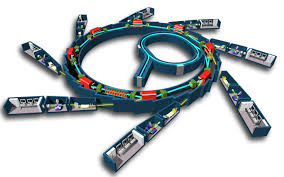Synchrotron : Circular Particle Accelerator

China’s latest scientific milestone, the High Energy Photon Source (HEPS), set to be the first fourth-generation synchrotron light source in Asia, will begin operations by the end of this year.
- A synchrotron is a type of circular particle accelerator, where particles move in a loop.
- It works by accelerating charged particles (electrons) through sequences of magnets until they reach almost the speed of light.
- These fast-moving electrons produce very bright light, called synchrotron light.
- This very intense light, predominantly in the X-ray region, is millions of times brighter than light produced from conventional sources and 10 billion times brighter than the sun.
- The light is channelled down beamlines to experimental workstations, where it is used for research.
- Scientists can use this light to study minute matter such as atoms and molecules.
- They can examine how a sample scatters, diffracts, absorbs, or reemits the synchrotron light, which reveals various different details of structure or chemical composition.
- There are approximately 70 synchrotrons around the world in various stages of development.
- There are technical differences between the use and capabilities of synchrotrons, with some being used for appliances and others for fundamental/theoretical research.




